
| Cwmbach | |||||||||||||||||||||||||||||||||||||
| Cwmbach like most of the Cynon Valley was a quiet isolated area before the coming of industry. Its rural calm was first disturbed by the building of the Aberdare canal , which opened in May 1812, with traffic passing through the area now known as Cwmbach in order to reach the canal head further to the north or join with the Glamorganshire canal to the south. Originally opened for trade with the iron industry of the Aberdare region, the canal found itself ideally situated when in 1837 the first export steam coal pit was sunk in Cwmbach. | |||||||||||||||||||||||||||||||||||||
|
|||||||||||||||||||||||||||||||||||||
|
The following 'boom' in the steam coal trade led to a rapid development of colliery workings in Cwmbach and an increase in its importance to the canal as evidenced by the existence of a small dock in Cwmbach. Indeed so great was the volume of coal being produced in the valley that the canal continued to operate until the early part of the 19th century despite intense competition from both the Taff Vale (1848) and Great Western (1864) railways.
The opening up of Cwmbach as a thriving coal mining area led to the development of the modern town we know today. With houses being built to accommodate the large numbers of people arriving to work in the collieries. By 1861 a number of streets had already been built, these included Timothy Row, Scales Row, Ynyscynon Street and Little Row. Commercial properties were also quickly established in the village and amongst the usual grocers, shoemakers and drapers was the first Co-operative store to open in Wales. Public houses were opened, some of the earliest being the Colliers Arms (1841), the Scales Arms (1845) and the Crown Inn (1851). |
||||||||||||||||||||||||||||||||||||
Religious buildings opened, with the Baptists opening a chapel in 1841, the independents opening a small chapel known as Capel Bricks in 1846 and the Calvinistic Methodists opening a chapel at Tir Bach in 1852. The Established Church did not immediately find a base within the village and it was not until 1882 that St. Mary Magdalene's Church was opened. Other notable buildings opened during this period of growth include the Cwmbach Public Workmen's Hall built in 1911 and Cwmbach Mixed School built around 1868. Right: St Mary Magdalene's Church
|
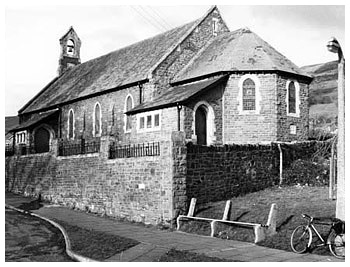 |
||||||||||||||||||||||||||||||||||||
| Cwmbach Co-operative Society - The first in Wales | |||||||||||||||||||||||||||||||||||||
| The pioneers of the Co-operative movement in Wales came from Cwmbach. They were John Rees, a collier who became the first manager of the Society, and David Thomas, a mechanic at the Lletty Shenkin colliery. Their interest in the movement had been aroused by a series of letters printed in the columns of Reynold's Newspaper dealing with the history of the Rochdale Pioneers. These articles in connection with the events surrounding the disastrous strike of 1857, during which the colliery owners had closed the company provision shops, encouraged them to consider establishing a Co-operative Society in Cwmbach. They took the bold step of convening a public meeting of the residents of Cwmbach to discuss the question. The meeting was held on October 9th, 1859 at the Mount Pleasant Inn, during which it was resolved to make a start and fifty-six members joined that night. | |||||||||||||||||||||||||||||||||||||
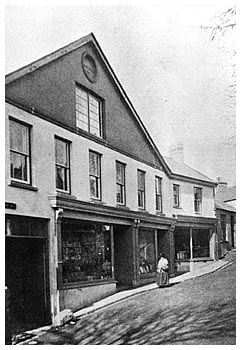 |
The meeting was held on October 9th, 1859 at the Mount Pleasant Inn, during which it was resolved to make a start and fifty-six members joined that night. Suitable premises close to the Aberdare Canal were found at cottages known as Capel Bricks and their first store was opened on the evening of March 8th, 1860. This was the first Co-operative store to be opened in Wales, some fifteen years after those in England. The Society at this time was known as Messrs. D. Thomas and Co. Limited in honour of their founder member. Later it was to adopt the more correct title of Cwmbach Industrial Co-operative Society Limited. The original store was a great success and by the end of the first year of trading, membership had risen to 174. Other branches were later opened at Aberaman in 1874, Cwmaman in 1883, and Mountain Ash in 1892. In 1900 the original establishment was renovated and enlarged in order to be equal in every respect to its other branches. Left: The Co-op in the early part of the 20th century |
||||||||||||||||||||||||||||||||||||
During the early part of the 20th century however the society began to lose trade, due mainly to stiff competition from the Aberdare Society, who regularly offered a higher dividend than the Cwmbach Society, and the effects of industrial action in the coal industry. In 1927 the Society entered a new chapter in its history when it merged with the Aberdare Co-operative Society to form the Aberdare and District Co-operative Society Limited'. The original store continued to sell goods for a number of years following this merger but was demolished in March 1977 to make way for a new housing venture. Right: The Co-op in Bridge Street during demolition |
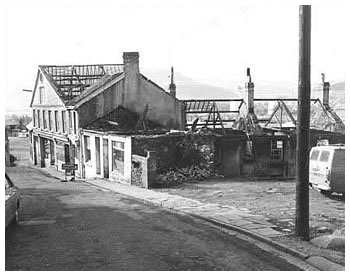 |
||||||||||||||||||||||||||||||||||||
| Cwmbach Male Voice Choir | |||||||||||||||||||||||||||||||||||||
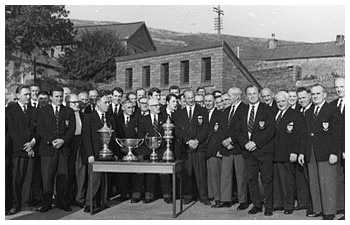 |
The Cwmbach Male Choir was formed in 1921. Local history being that they were formed at a local cricket match held in June 1921. A number of the crowd watching the game became uninterested in the play and began to sing hymns and part songs. This led to the suggestion that a Male Voice Choir be formed. From this a meeting was held at the Cwmbach Hall and Institute and the Cwmbach Male Voice Choir became a reality. |
||||||||||||||||||||||||||||||||||||
| Over the years the choir has become much travelled having appeared at the Royal Festival Hall, The Royal Albert Hall, The Barbican, St David's Hall and numerous other venues throughout the country. Their first international trip was in 1961 when they travelled to Hungry to perform at the Bela Bartok Festival, becoming the first Welsh Choir to sing behind the 'Iron Curtain'. Since then they have visited and performed in France, Belgium, Holland, Germany, Ireland, Spain, Canada and South Africa. From the late 1950,s onwards the Choir has been involved in a variety of broadcast programs both on radio and television, and have produced a number of recordings on record, tape and CD, the first being a record produced in 1960 called 'Male Voice Favourites'. They were also the first choir to sing at the famous Arms Park prior to an international rugby match. The choir continues to thrive today and still upholds the high standards set by their founder members over 80 years ago. |
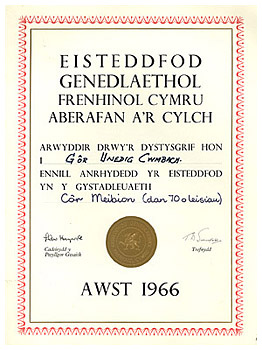 |
||||||||||||||||||||||||||||||||||||
| Cwmbach Coal Industry | |||||||||||||||||||||||||||||||||||||
| Cwmbach can be said to hold a special place in the history of the steam coal trade in the Cynon Valley for it was here that the first deep pit was sunk for the sale of coal. The pioneer of this trade was one Thomas Wayne, the son of Mathew Wayne, ironmaster and coalmaster of Merthyr. His interest in the coal trade was aroused by the success of Lucy Thomas of Waun-Wyllt in Merthyr, who in 1830 made an agreement with George Insole to sell coal in the London area. The coal was soon selling so well that in a few months Mrs. Thomas found that she could sell all her coal at the mine-head for the fabulous price of 4s. 0d. a ton. | |||||||||||||||||||||||||||||||||||||
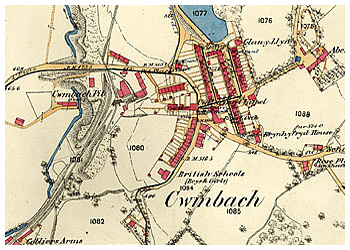 |
Thomas Wayne persuaded his father and elder brother that an attempt should be made to reach the famous four-foot seam of steam coal. They felt that this seam would be found in Cwmbach and made an agreement with the owners of the Abernant-y-Groes Estate to sink a pit and work any coal found on the estate. Sinking of the Abernant-y-Groes colliery (later known as Cwmbach Colliery) began in June 1837 and by December of that year they had sunk the shaft 60 feet and reached the steam coal they were seeking. Left: Abernant-y-Groes Pit is shown on this 1868 OS map marked as Cwmbach Pit by which name it was then known. |
||||||||||||||||||||||||||||||||||||
The people involved with the venture immediately formed the Wayne's Merthyr-Aberdare Steam Coal Company and by the end of December coal from the colliery was being exhibited in London. The partners in the company were Matthew Wayne, Thomas Wayne, W.W. Wayne, William Thomas David, Gwladys David and William Morgan. The company was to prove a huge success and in 1840 sent over 40,000 tons of coal down the Aberdare canal. The colliery was abandoned in 1896. Right: Abernant No. 9 Colliery owned by Richard Fothergill |
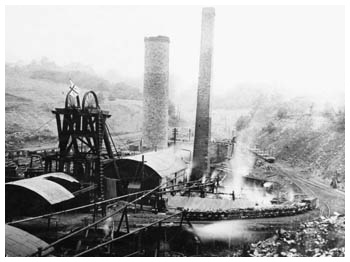 |
||||||||||||||||||||||||||||||||||||
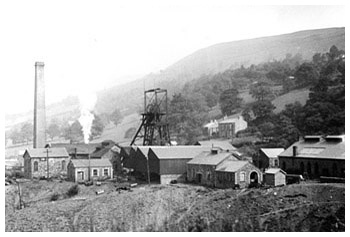 |
Left: Lletty Shenkin Colliery which operated until late in the Twentieth Century |
||||||||||||||||||||||||||||||||||||
|
|||||||||||||||||||||||||||||||||||||
|
|||||||||||||||||||||||||||||||||||||

